Coffee is an integral part of many people’s lives. Lovers of psychoactive substances may often drink a few cups of coffee in the morning on the day of use, unaware that they will be using a psychostimulant on the same day. In the case of mephedrone, the question arises as to whether mephedrone and caffeine are compatible. You can read about this and much more in this publication.
Cathinones, which are monoamine alkaloids produced from the khat plant (Catha edulis), are taken recreationally by people who desire to feel euphoric, have less inhibition, improve their sensory abilities, and have more energy, libido, and empathy for other people. As a result of their comparable chemical structures, the naturally occurring beta-ketone found in the leaves of the khat plant produces the same hallucinogenic effects as amphetamine when eaten (Figure 1).
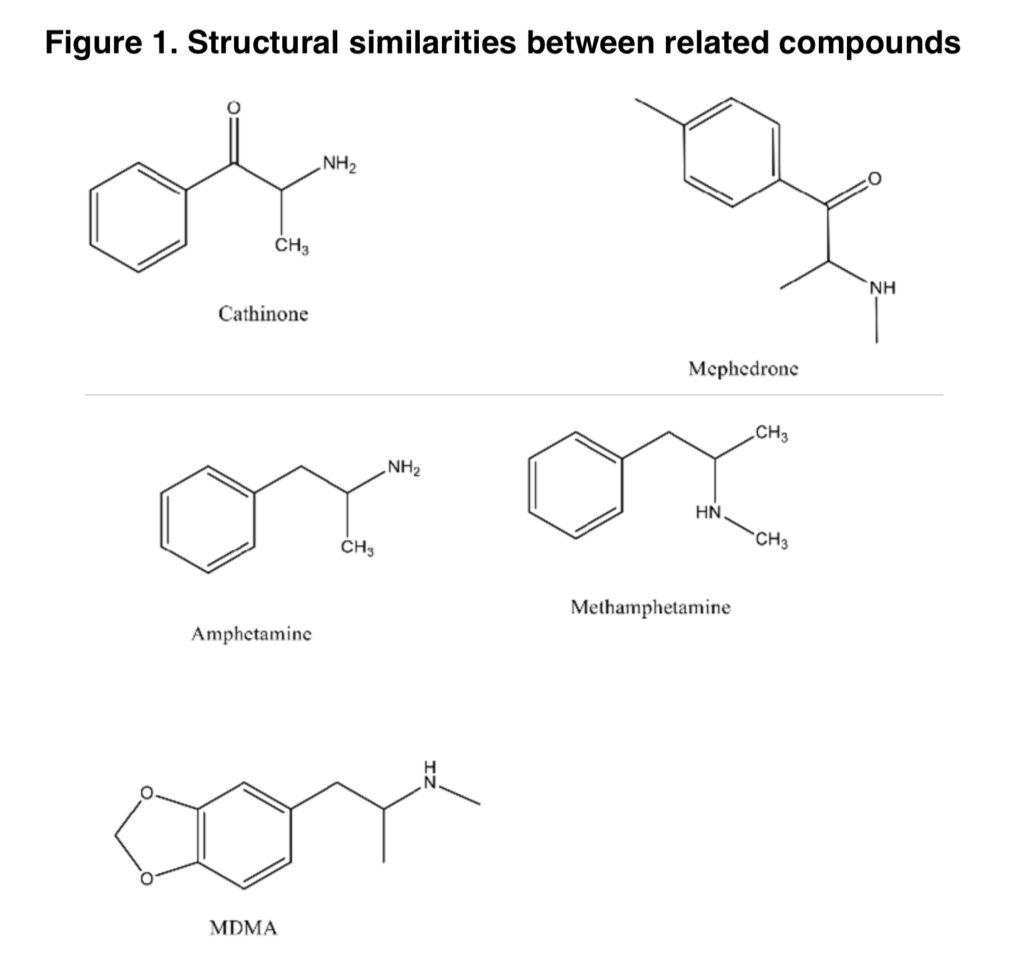
Khat is a plant that is indigenous to East Africa and the Arabian Peninsula, and historical records indicate that Ethiopia has been using it since the 13th century. It wasn’t sold internationally to countries like the United States and the United Kingdom until the middle of the 20th century. Patient reports show that it is still commonly used with 200 million people worldwide chewing khat for its stimulant effects, there being notably high prevalence in Yemen, Kenya, Ethiopia, Eritrea, Somalia, and Saudi Arabia.
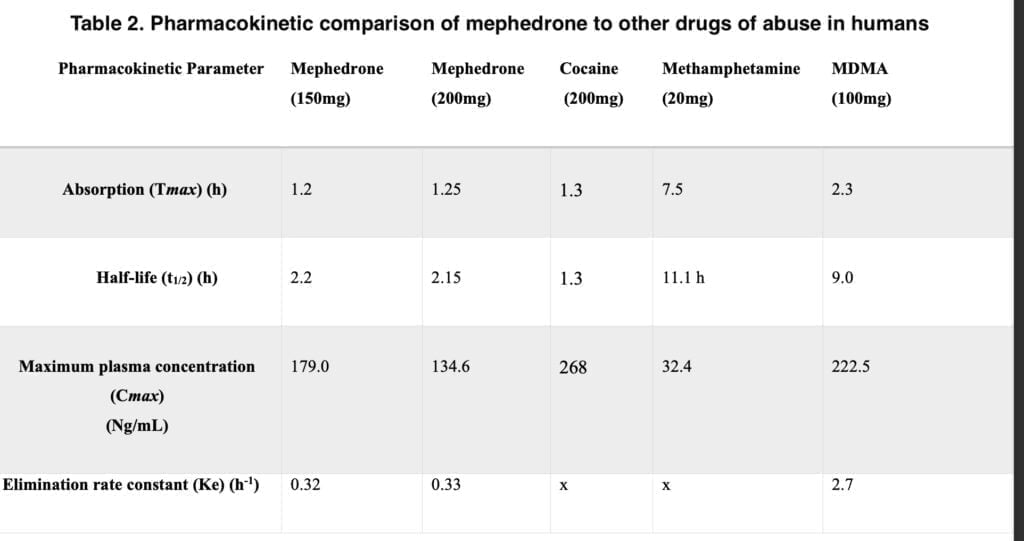
Mephedrone and caffeine: basics of use
Mephedrone is most frequently self-administered by insufflation, but it is also taken orally and, less frequently, intravenously. According to reports, oral dosages typically fall between 75 and 100 mg, as opposed to 20 to 80 mg for insufflation.
Mephedrone’s poor bioavailability when taken orally compared to its high bioavailability when inhaled is the explanation for the greater dosage seen with oral administration, which also explains why recreational users prefer to give via insufflation. Mephedrone’s pharmacokinetics take the amount and timing of administration into account. Mephedrone readily crosses the BBB because it has a brain-to-plasma ratio of 1.85.
The rapid absorption time (Tmax) seen in both rats and humans is consistent with this. In humans, a dose of 150 mg of mephedrone ingested orally produces a Tmax of 1.2 hours, t1/2 of 2.2 hours, Cmax of 179 ng/mL, and has a Ke of 0.32 h. In rats, an oral dose of 30mg/kg has a Tmax of 0.93h, a Cmax of 331 μg/kg, and a T1/2 of 2.15 hours.
Mephedrone has a shorter half-life than MDMA, which helps to explain why recreational users redo more frequently, much like cocaine. Given the obvious variations in pharmacokinetics between these substances and other, structurally related drugs of abuse, as described in Table 2, it is crucial to understand a substance’s entire profile rather than forming assumptions based on these similarities.
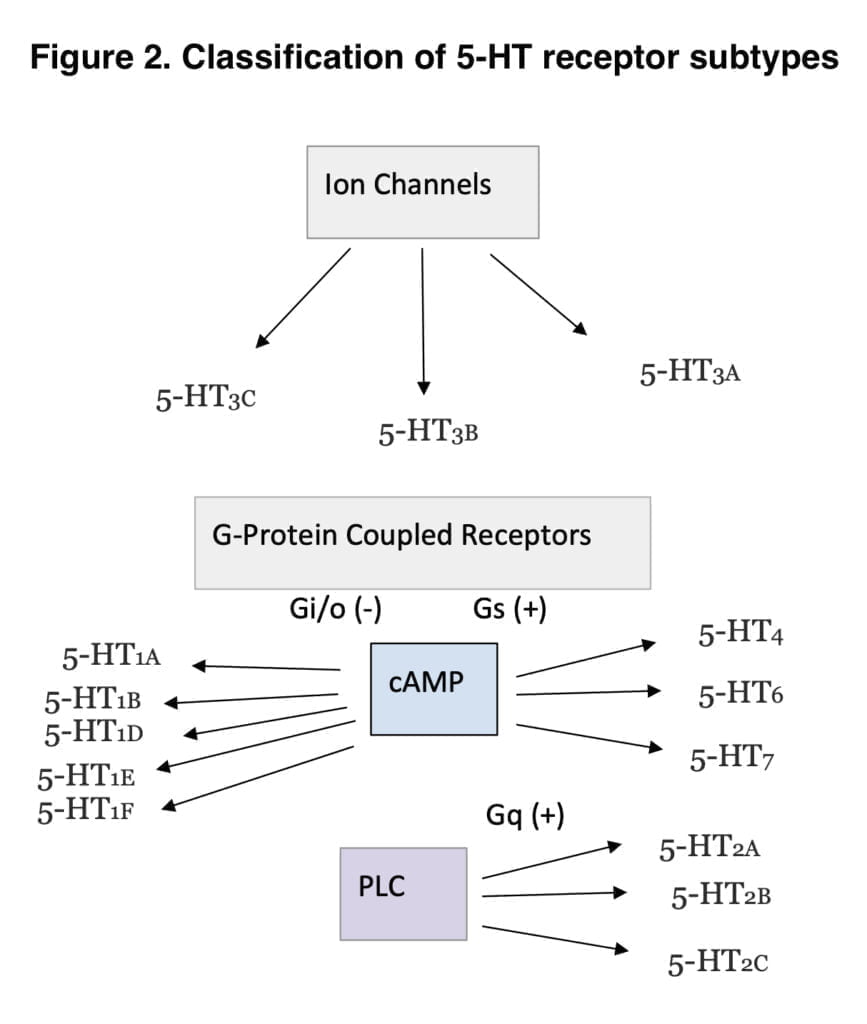
Mephedrone’s non-selective action on the noradrenergic transporter, serotonin (5-HT) transporter, and DAT (dopamine transporter) is well established (NET). Mephedrone has the most affinity for SERT, and is subsequently followed by DAT and NET, in that order (Table 3).
According to earlier research, mephedrone binds to these transporters and prevents the reuptake of the corresponding monoamines. The concentration of the monoamines rises as a result, causing the effects seen in users. Other addictive substances also work in a manner similar to this to achieve their effects. Serotonin neurons are primarily located in the brain stem, specifically in the dorsal and median raphe with projections to the forebrain and brainstem.
The 5-HT1A receptor is expressed as a pre-synaptic auto receptor, or as a post-synaptic heteroreceptor and is coupled to an inhibitory G-protein, in which activation of this receptor results in inhibition of 5-HT release via the opening of K+ channels. 5-HT axons have been shown to innervate DA fibres.
Many studies have documented the complex relationship between the monoamines, including a study which found lesions of 5- HT and noradrenergic (NE) neurons resulted in increased firing rate of DA neurons in the VTA. Long-term cocaine use increases SERT density in the cortex and lateral septum while also raising extracellular 5-HT levels, demonstrating the role of the serotonergic system in the neurobiological alterations that characterize addiction.
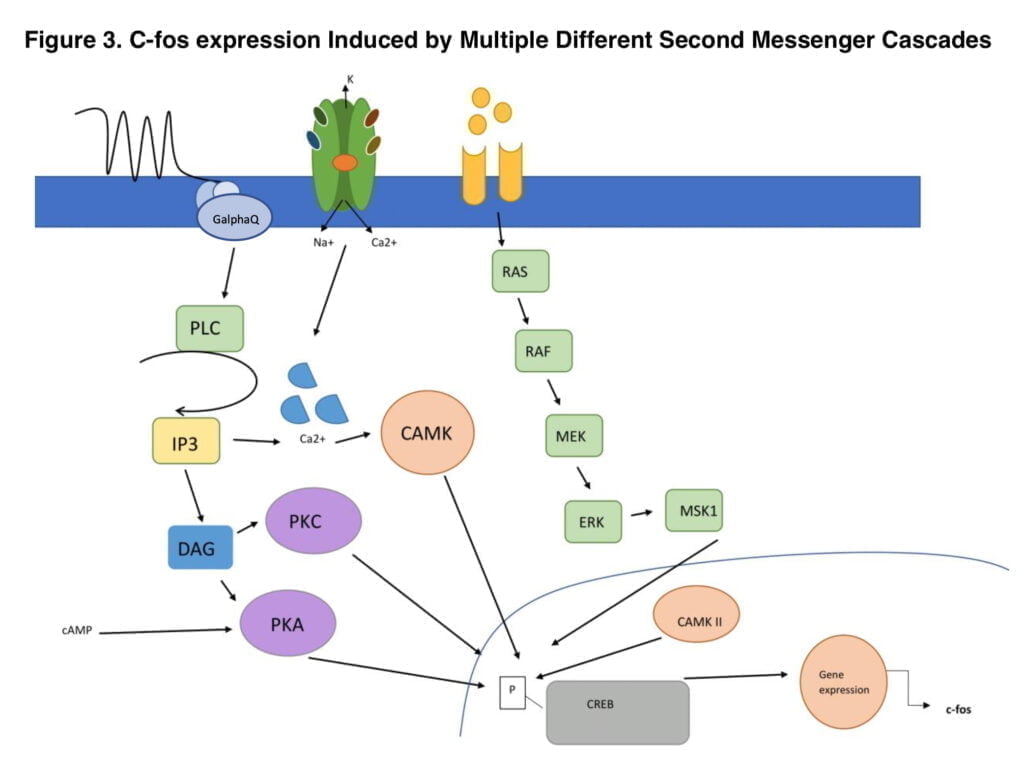
A naturally occurring methylxanthine, caffeine (1,3,7-Trimethylpurine-2,6-dione) is the most widely used psychostimulant in the world. Caffeine, which mostly comes from coffee beans, is commonly ingested in beverages like coffee and energy drinks and primarily causes its effects by non-selectively antagonisting the A1 and A2 receptors.
Caffeine, which is primarily found in caffeinated beverages, rapidly crosses the blood-brain barrier (BBB) and reaches a peak blood concentration within 30 to 60 minutes of consumption, which accounts for the quick onset of the stimulant effects felt by consumers after consuming a caffeinated beverage. The P450 enzyme in the liver breaks it down. The main metabolites of caffeine are paraxanthine, theobromine, and theophylline.
Caffeine is broken down through demethylation to dimethylxanthines. Caffeine has a lengthy half-life, thus it can linger in the body for up to 10 hours before the kidneys excrete it. It is believed that adenosine receptors influence the effects of psychostimulants by forming heterodimers with other receptors, which modify the reactions observed when each receptor is activated. It is well known that adenosine signaling influences the transmission of dopaminergic signals.
Since A1 receptors are known to negatively modulate D1 receptors, caffeine’s antagonistic effects on these receptors may act to increase D1 receptor signaling, including an increase in cAMP, which would then increase cAMP-dependent responses. This may be partially attributable to the dimerization of the A2A and D2 receptors, as well as the A1R and D1R receptors (Figure 4), which leads to an increase in c-Fos expression and allosteric regulation.
This idea is strongly supported by earlier research, which shows that A1 and A2 receptor agonists lower striatal dopamine levels and that activation of the A2A receptor alters the D2 receptor’s affinity for dopamine by reducing DA binding. Additionally implicating the adenosine receptor family in the regulation of drug-induced monoamine release and, subsequently, their downstream effects, it has been shown that the A2A receptor may form dimers with the 5-HT1A receptor. These findings complement those of the DA receptor.
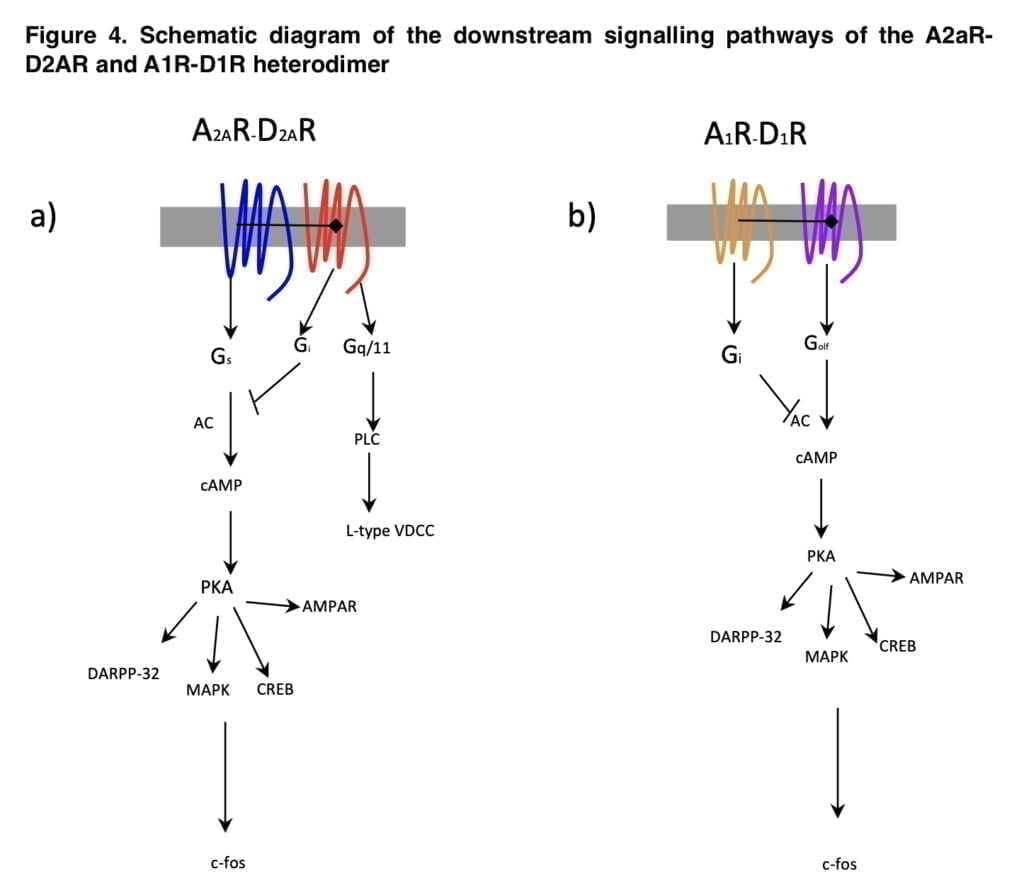
Experimental approach and justifications
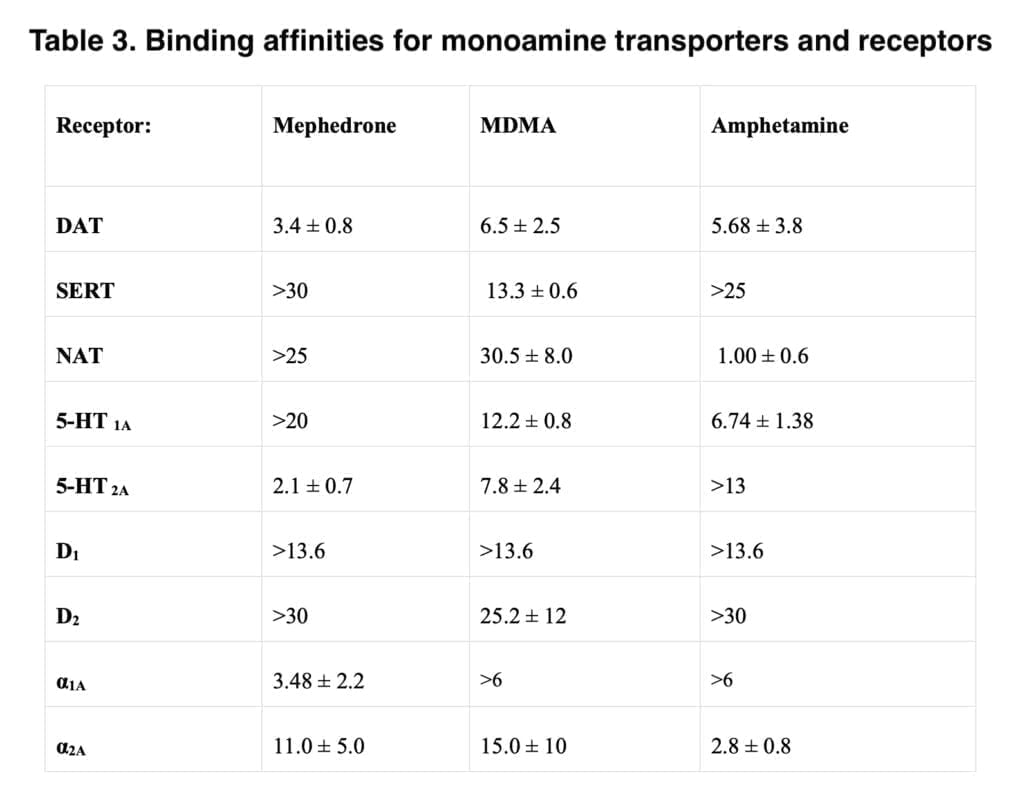
Mephedrone has been shown to affect locomotor hyperactivity and hypothermia, which are temporarily mitigated and avoided by pre-administering the 5-HT1A antagonist WAY-100635. Additionally, when mephedrone and caffeine are administered together, mephedrone is more likely to cause hyperactivity, convert hypothermia to hyperthermia, and cause stereotyped behaviors that resemble serotonin syndrome, all of which pose a greater danger to one’s health. This is because many clubgoers consume highly caffeinated drinks along with recreational drugs, along with the known negative interaction of caffeine with stimulant drugs of abuse.
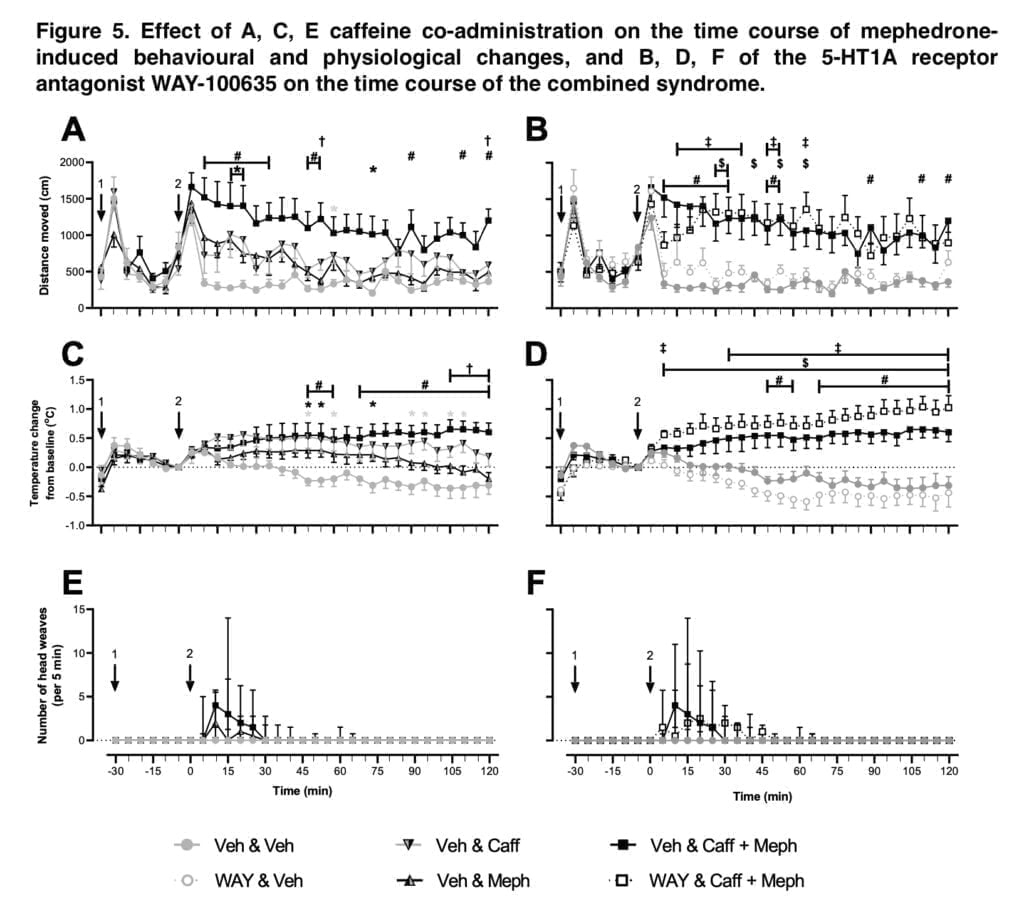
The effect of coadministration of caffeine and mephedrone, as well as the influence of 5-HT1A antagonism, is examined in this publication. The dosage and experimental strategy utilized here were in line with other investigations into the neuropharmacology of mephedrone. For instance, the mephedrone dose (10 mg/kg) was chosen because it has been demonstrated to cause locomotor activity, and the caffeine dose has been previously shown to enhance mephedrone induced locomotion, whilst converting the mephedrone induced hypothermia to hyperthermia.
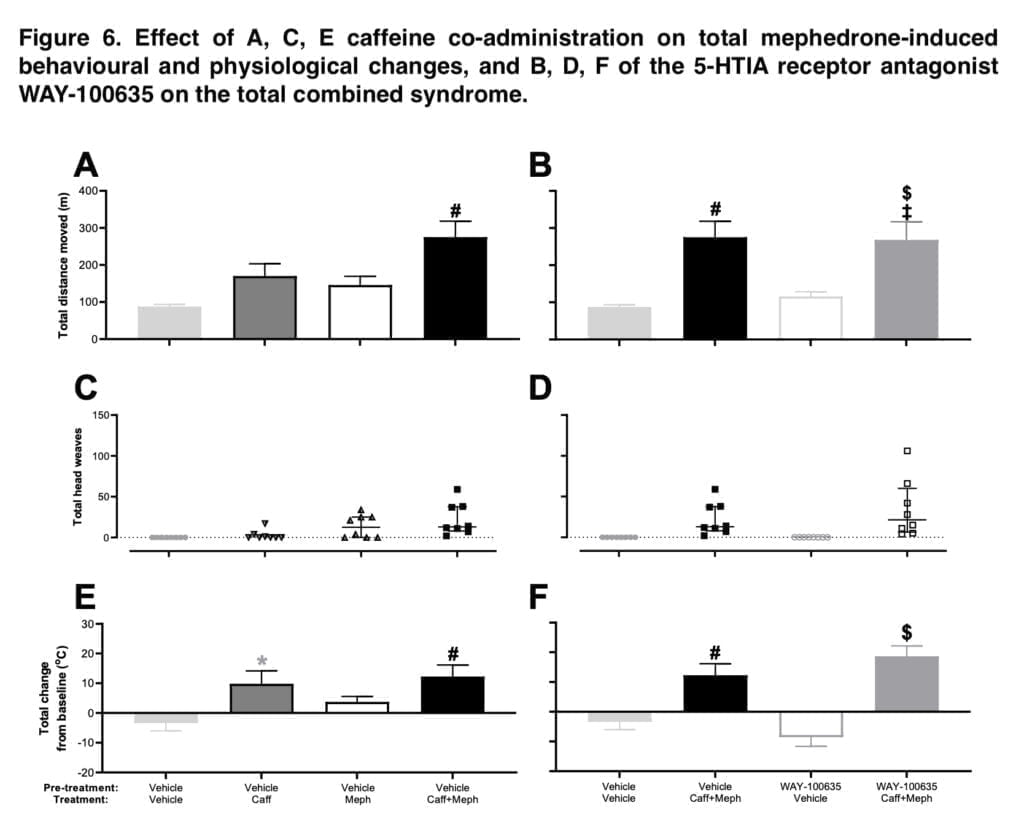
In order to determine whether 5-HT1A receptor activation is a factor in the enhanced mephedrone-induced behavior and thermoregulatory response, the experimental design also included double blinding of the data, a total of 6 treatment combinations, and analysis of the interaction between caffeine and mephedrone. WAY-100635+ caffeine, and WAY- 100635+Mephedrone were not included as treatment groups, as the current study aims to investigate only the interaction of caffeine and mephedrone, and the influence of WAY-10- 635 on the combined effect of caffeine and mephedrone.
Although this resulted in an unbalanced design, it allowed a reduction of 16 animals used overall in the experiment. A pilot study was conducted to determine the optimal antibody concentration to observe c-fos expression, whereby the protocol was conducted with varying concentrations of antibody. In addition, c-fos was used to measure the density of cells responding to caffeine and mephedrone, as this is an established marker to identify neuronal activation following psychostimulant administration.
Analysis of experimental results and discussion
The main findings of this study are:
- Mephedrone alone increases c-fos expression in the NacS;
- Caffeine co-administration with mephedrone increases c-fos expression above control while neither caffeine nor mephedrone alone have any significant effect in both the NacC and NacS, alongside the ventral striatum and the prelimbic cortex;
- Inhibition of the 5-HT1A receptor by WAY-100635 did not have an impact on mephedrone and caffeine induced c-fos expression nor influence any of the behavioural or physiological measures studied;
- Mephedrone-induced locomotion and head weaving displayed a significant correlation with c-fos expression in the dorsal striatum, and both the NacC and NacS.
The NacS and NacC showed a favorable connection with temperature change. The current research adds to the body of knowledge on the psychoactive effects of mephedrone by demonstrating that co-administration of coffee affects the amount of locomotor activity and body temperature changes mephedrone causes in rats.
According to behavioral tests, which indicated that combination treatments increased locomotion, body temperature, and stereotyped behavior while having no effect on WAY-100635, the data also demonstrate that caffeine boosts mephedrone-induced c-fos expression in the areas under investigation. Although it was anticipated that WAY-100635 would reduce c-fos expression across all of the areas of the brain that were studied, the lack of inhibition is closely correlated with the drug’s lack of impact on the behavioural and physiological responses.
Given that pre-treatment with WAY-100635 has been shown to completely reverse the hypothermia caused by mephedrone, it was hypothesized that this inhibition of the 5-HT1A receptor triggered by combination therapy would affect both the expression of c-fos and behavioral responses.
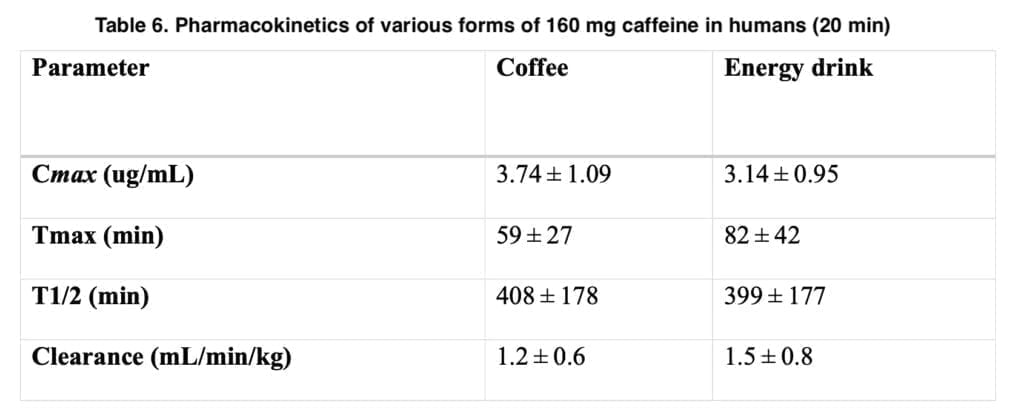
Mephedrone administration alone did not alter c-fos within the NacC, dorsal or ventral striatum, which is consistent with the idea that striatal subregions mediate different and specific functions. However, c-fos expression might have been expected to increase throughout the striatum, due to its known involvement in addiction and results of previous studies.
For example, other groups showed mephedrone elevated c-fos expression has been observed in the ventral striatum, NacC, NacS and PFC unlike the current study with a more restricted pattern of c-fos expression. This disparity is most likely due to the higher doses used in these previous studies compared to those used in the current study, alongside the different routes of administration (15 and 30 mg/kg, i.p., compared to 10mg/kg, s.c.), so it is possible that more diverse c-fos expression would have occurred in the current study if a higher dose had been used.
Due to prior research showing that WAY-100635 affects mephedrone, MDMA, and 8-OH-DPAT produced hypothermia, we hypothesized that inhibition of the 5-HT1A receptor by WAY-100635 would reduce c-fos expression generated by mephedrone and caffeine co-administration. However, WAY-100635 had no effect on the co-administration treatment-induced induction of c-fos expression, which was not anticipated based on prior research.
It has been demonstrated that 5-HT1A agonists can lower body temperature, and it has also been demonstrated that WAY-100635 can augment the hyperthermia brought on by DOI, a 5-HT2A/C agonist, emphasizing the significance of the 5-HT1a receptor in thermoregulatory responses. This suggests that the 5-HT2A/C and the 5-HT1A receptors interact in the modulation of body temperature, and perhaps combination treatment influences this interaction between these receptors, in which the 5-HT2A/C receptor primarily mediates this response, justifying why WAY-100635 had no impact on the thermoregulation.
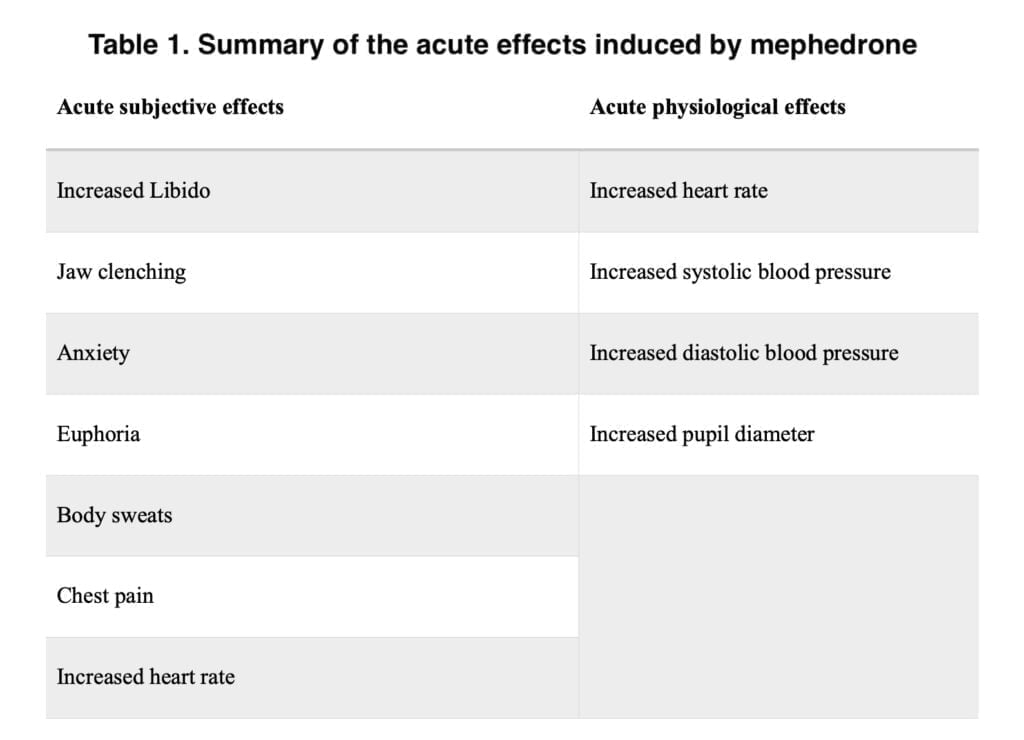
The mediating role of other receptors in the combination therapy’s effects must be greater. The role of the 5-HT1B receptor in mediating the effects of mephedrone has been shown in earlier research. For instance, Shortall observed that 5-HT1B receptor inhibition reduced the hyperactivity caused by mephedrone. Furthermore, persistent, acute cocaine bingeing elevated 5-HT1B receptor by 80% in the NacC and DS, underlining the significance of the 5-HT1B receptor in the mediation of psychostimulant produced effects.
5-HT1B knockout mice failed to generate a CPP following different dosages of cocaine. Specifically, 5-HT1B receptors in the Nac have proved particularly important, with activation of the 5-HT1B receptors in the Nac reducing amphetamine self-stimulation, whilst also attenuating the response-potentiating effect of amphetamine. It is believed that 5-HT1B located on GABAergic terminals that project from the Nac to VTA inhibit GABA release which ultimately disinhibit neurons within the VTA, inducing the effects mentioned above.
The fact that mephedrone has a high affinity for the 5-HT2A/2C receptors suggests that it may be the cause of these effects. M100,907, a 5-HT2A receptor antagonist, reduced the effects of cocaine on locomotion, whereas SB242,084, a 5-HT2C receptor antagonist, had the opposite effect and increased the effects of cocaine on locomotion.
Conclusion
The results of the current investigation show that mephedrone and caffeine have additive effects that are similar to those of MDMA and caffeine. These findings point to the possibility of additional negative effects in recreational users and emphasize the significance of understanding the pharmacology of co-administered drugs of abuse in order to examine any interactions and negative effects that may result. This will aid in the development of efficient treatments for the negative effects of psychostimulants and lessen the harm caused to human users.
Although this study did not identify the receptors involved in the downstream effects induced by combined treatment because, unlike mephedrone alone, these appear insensitive to 5-HT1A receptor blockade, it will permit future studies to identify the specific receptors involved by inhibiting other potential targets. This is especially important in recreational drugs of abuse which are frequently combined with adulterants, like caffeine.
